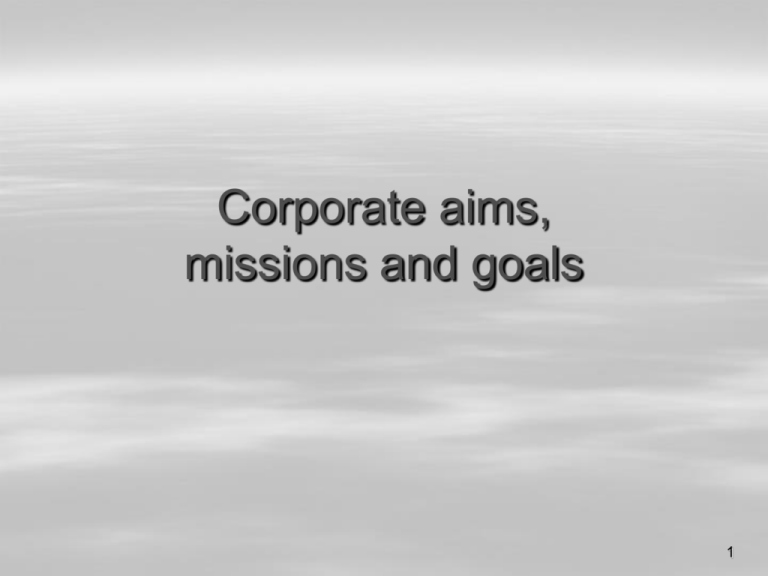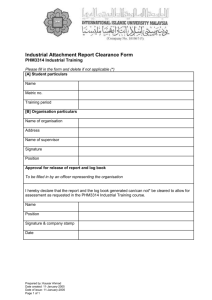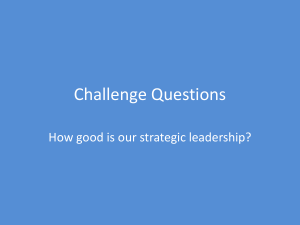Corporate aims, missions and goals
advertisement

Corporate aims, missions and goals 1 1. Corporate aims Express the long-term intention of the organisation to develop in a certain way. Everyone in the organisation should work towards achieving a common vision Help build team spirit, encourage commitment Example McDonald‘s: provide friendly service in a relaxed, safe and consistent restaurant environment Small companies do not write down their aims M.R. 2 Corporate aims Whether stated or unstated – corporate aims act as a basis upon which to form goals or objectives for the organisation allows delegation 3 2. Mission statement a qualitative statement of the organisation aims – intended to motivate within the firm and to convince those outside it of the company‘s commitment attempt to put corporate aims into words should identify positive characteristics such as creativity and quality rather than maximising profit 4 The mission model Purpose Values Standards and behaviour Strategy Are interdependent E.g. Unilever: raise the quality of life Coca-Cola: our mission is to get more people drink Coke than water 5 3. Purpose Identification for employées‘ work. Mission statement identifies several stakeholders in whose interests the business is said to be run 6 4. Values The values reflect the beliefs among the employées. This unwritten code is called culture of business Mission statement provides an opportunity to shape this business culture Set of values which employees can feel proud of – motivates them to work towards the organisation‘s objective Difficult in large companies where each department has its own culture – no dominant corporate culture 7 Sources of business culture Company routines – everyday decisions Formal controls – organisation structure (vertically by functions, horizontally by layers of hierarchy) Peer structure – interrelationships between individuals and groups Symbols: language, signs of status Rituals and myths – behaviour, stories from the past 8 Attitudes and business culture Body shop – soft, less profit-focused culture more socially based (opposite: shareholder) 9 Approach to key issues Attitude towards risk: entrepreneurial – risk averse Reward distribution: ‚them and us‘ – fat cats Teamwork Equity: more based in small firms (Nissan plant in Sunderland) 10 Types of business culture Power culture – pleasing the boss Role culture – power depends on the position Task culture – power lies in the expertise Person culture – within functional departments (lawyers, accountants) Principal reason for introducing a mission statement: provide a common purpose amongst employées 11 Behaviour standard IBM: all managers should operate an open door policy Criticism: mission statements are only part of a PR strategy Missing link: identify the standars of behaviour expected from the employees which symbolise the purpose, strategy and values of the organisation 12 Developing a mission statement If all staff are involved in preparing (and agree the outcome) – a mission statement, the result will be a statement of shared values E.g. clothing retailer: maximise sales and serve the customer in the best way E.g. a woman tries on, appears to like, a dress which looks ill-fitting at the back, should you step in to point this out? All staff should answer in the same way. The sales-driven staff might say no. The risk of losing the sale would be too great. Focus on the customer: yes customer confident in the honesty of the staff, will return. 13 Length of a mission statement Can vary 1 page single phrase Others prepare extensive documents consisting of the purpose, strategy and values of the organisation in detail Statement should be memorable 14 Criticism of mission statements No purpose than to gain publicity Common for quite different companies to have very similiar mission statements Time and effort could be used more effectively elsewhere in the business Even when the statement sets out the organisation‘s purpose, strategy and values – firms fail to implement the ideas 86 % of the organisations have a mission statement 15








